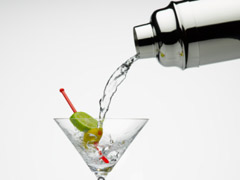


If you’ve ever claimed to be sipping gin for “medicinal purposes” you wouldn’t be telling a complete porky. The drink, which has only recently started to shake off its dismal reputation, was first conceived in 17th century Holland by a Dr. Silvius. His aim was to create a medicine to help with kidney problems, hence the main ingredient being juniper, a diuretic. Juniper berries are responsible for giving gin its characteristic aroma, and Silvius named the drink “Genever”, Dutch for juniper.
It is believed gin arrived in the UK thanks to British soldiers returning from fighting in the Thirty Years War. The soldiers were given small amounts of the spirit to keep warm before going onto the battlefield, hence the term “Dutch courage”. By the late 17th century gin was being distilled in London, as production was cheap. Beer was subjected to heavy taxation, making gin the cheapest booze available. It gained even more popularity when a law was passed which enabled anyone to make gin in the comfort of their own home.
To top it all, water was unsafe to drink at the time, so one can imagine the lethal quantities being consumed. If you’re wondering how anyone would be capable of downing neat gin like it’s water, it’s nigh on impossible, but the gin produced in 18th century England was heavily sweetened. Gin shops sprang up all over London, and sellers employed slogans like “drunk for a penny, dead drunk for a tuppence, clean straw for nothing”. The drink became associated with poverty, and public drunkenness and illnesses relating to alcohol abuse were commonplace. The term “Mother’s Ruin” stems from the fact that gin shops permitted women to drink alongside men for the first time, and supposedly those who abused the spirit neglected their children or turned to prostitution.
In 1736 a law was passed making it illegal to buy gin in small quantities, leading to a black market that resulted in even more devastating effects. Illegal gin was made using precarious methods and was therefore a lot more toxic, as sulphuric acid and turpentine were sometimes used in the brewing process. Smugglers sold it under the names “Ladies Delight”, “Strip-me-Naked” and “Cuckold’s Comfort”. Once it was clear the ban had served no purpose, six years later it was reversed.
\n\nIn 1750 Hogarth created the famous drawing ‘Gin Lane’, as part of a campaign in support of the restriction of sales of gin. The grim scene is set in Bloomsbury, and London has seemingly been torn apart by alcohol abuse. There is a cast of downtrodden characters including a semi-naked woman not realising her baby is about to fall to its death, and a child sharing a bone with a dog.
A new distillation process developed in the 1830s meant the gin produced was of higher quality. Its reputation took a turn for the better during the Victorian era, when it started to appeal to the upper classes as a refined, ladylike alternative to whiskey and cognac. Lavish gin palaces replaced squalid gin joints, and the most popular were around Drury Lane, Holborn, St. Giles and Covent Garden.
By this point Londoners were drinking dry gin mixed with tonic water. Tonic was concocted in colonial India as an anti-malaria medicine. Ironically, gin was first added to the tonic to mask its extremely bitter taste, and a classic cocktail was born.
Gin became unfashionable yet again throughout the 20th century, due to its reputation for being an “old ladies” drink. Furthermore, many people still believed that gin had the capacity to induce depression due to its chequered history. It was passed over in favour of vodka, which has a less pungent aroma and works well in sweet cocktails.
Despite this, the drink’s fortune has changed dramatically of late. London’s current love affair with speakeasies, basement cocktail bars and all things vintage has led to a renaissance, with every other watering hole in the capital now attempting to offer classic gin-based cocktails to varying degrees of success.
\n\nTake the classic gin martini for instance. Every mixologist worth his salt knows that Vermouth must be swished around the glass and then poured out before adding the gin; the two are not mixed in together. The type of gin and Vermouth used are also key. The recipe below shows how to recreate this glamorous drink at home, the traditional way.
Dry Martini Recipe
Chill cocktail glasses with ice cubes or by leaving in the fridge for a couple of hours (don’t put them in the freezer, as they’ll crack if left for too long). Pour an ounce (28 ml) of dry Vermouth in and swirl it around the glass for a few seconds before pouring out. Noilly Prat is a good one, as well as the famous Martini, which is available extra dry. You will then need 3 ounces (85 ml) of gin, preferably Tanqueray 10; if not Tanqueray and Bombay Sapphire are good choices too. Pour the gin into the glass and garnish with either a twist of lemon for a citrusy flavour or a couple of green olives, which is the purist’s choice. Some bars have put their own spin on the final touch by adding things like a twist of orange peel, but while this may add a lovely fragrance, it works better with a sweeter drink.
And if you’re looking for somewhere to enjoy a gin-based tipple, try Powder Keg Diplomacy for Victorian-era cocktails, kings of the current crop of speakeasies Nightjar, and ultra-sophisticated, celeb-haunt The Connaught Bar.


